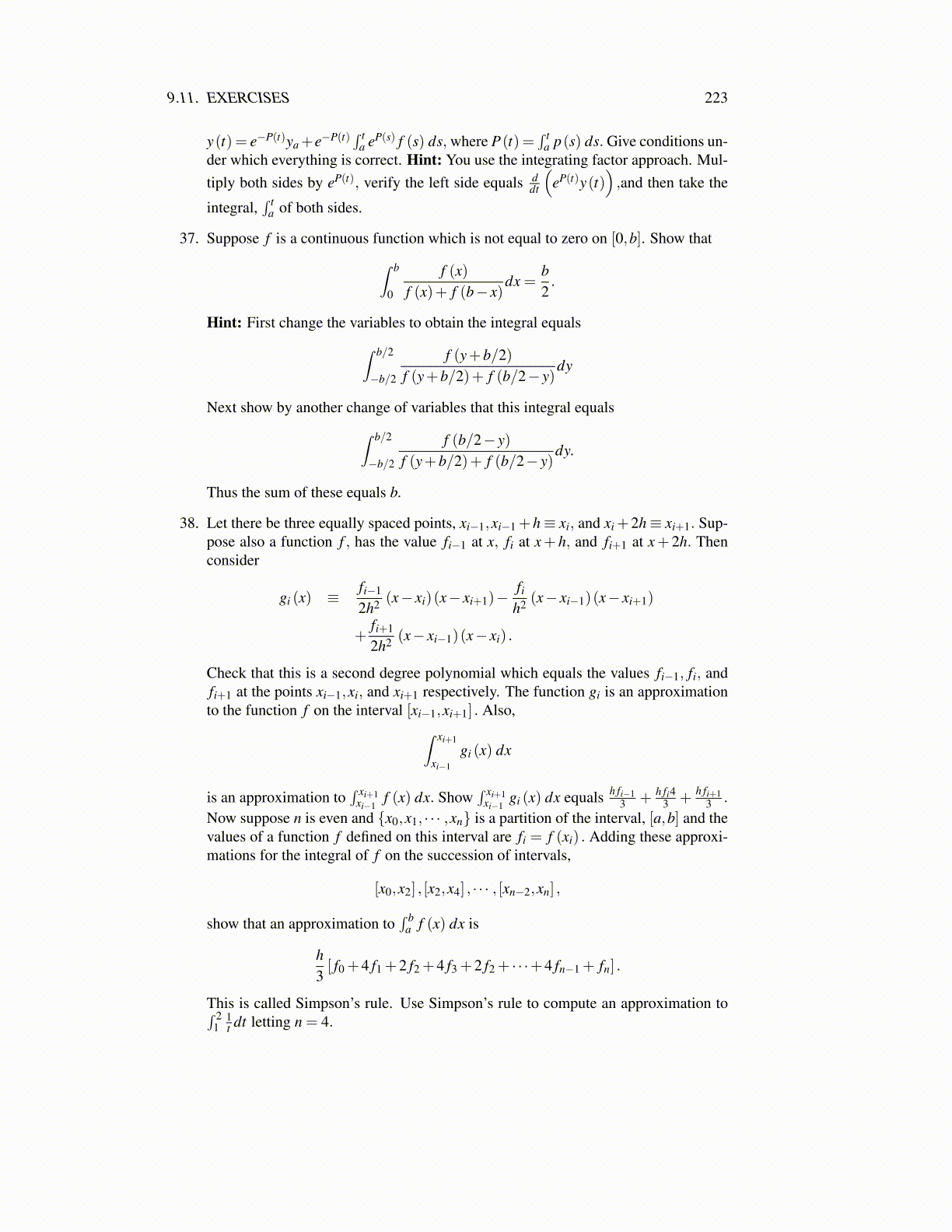
9.11. EXERCISES 223
where M satisfies, M ≥ max{∣∣∣ f (4) (t)∣∣∣ : t ∈ [xi−1,xi]
}. Now let S (a,b, f ,2m) de-
note the approximation to∫ b
a f (x) dx obtained from Simpson’s rule using 2m equallyspaced points. Show∣∣∣∣∫ b
af (x) dx−S (a,b, f ,2m)
∣∣∣∣< M1920
(b−a)5 1m4
where M ≥ max{∣∣∣ f (4) (t)∣∣∣ : t ∈ [a,b]
}. Better estimates are available in numerical
analysis books but these also have the error in the form C(1/m4
).
43. A regular Sturm Liouville problem involves the differential equation, for an un-known function of x which is denoted here by y,(
p(x)y′)′+(λq(x)+ r (x))y = 0, x ∈ [a,b]
and it is assumed that p(t) ,q(t)> 0 for any t along with boundary conditions,
C1y(a)+C2y′ (a) = 0, C3y(b)+C4y′ (b) = 0
where C21 +C2
2 > 0, and C23 +C2
4 > 0. There is an immense theory connected tothese important problems. The constant, λ is called an eigenvalue. Show that if yis a solution to the above problem corresponding toλ = λ 1 and if z is a solutioncorresponding to λ = λ 2 ̸= λ 1, then∫ b
aq(x)y(x)z(x)dx = 0. (9.13)
Hint: Do something like this:(p(x)y′
)′ z+(λ 1q(x)+ r (x))yz = 0,(p(x)z′
)′ y+(λ 2q(x)+ r (x))zy = 0.
Now subtract and either use integration by parts or show(p(x)y′
)′ z− (p(x)z′)′ y = ((p(x)y′
)z−(
p(x)z′)
y)′
and then integrate. From the boundary conditions, show y′ (a)z(a)− z′ (a)y(a) = 0and y′ (b)z(b)− z′ (b)y(b) = 0. The formula, 9.13 is called an orthogonality relationand it makes possible an expansion in terms of certain functions called eigenfunc-tions.
44. Letting [a,b] = [−π,π] , consider an example of a regular Sturm Liouville problemwhich is of the form y′′+ λy = 0,y(−π) = 0,y(π) = 0. Show that if λ = n2 andyn (x) = sin(nx) for n a positive integer, then yn is a solution to this regular SturmLiouville problem. In this case, q(x) = 1 and so from Problem 43, it must be thecase that
∫π
−πsin(nx)sin(mx)dx = 0 if n ̸= m. Show directly using integration by
parts that the above equation is true.
45. Suppose g is increasing and f is continuous and of bounded variation. By the the-orems in the chapter,
∫ ba f dg exists and so
∫ ba gd f exists also. See Theorem 9.4.1.
g ∈ R([a,b] , f ) . Show there exists c ∈ [a,b] such that∫ b
agd f = g(a)
∫ c
ad f +g(b)
∫ b
cd f